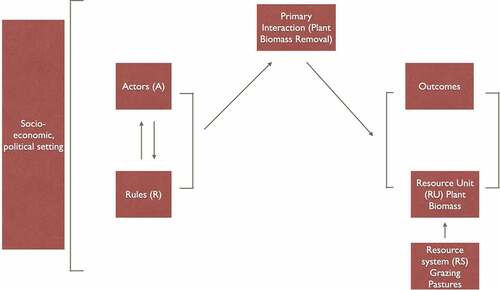Figures & data
Figure 1. Diagrammatic representation of the first-tier variables of the SES framework used to study the governance system for pasture plant-biomass removal from communal pastures in Kibber village, a high-altitude agro-pastoral system in the Indian trans-Himalaya. The Resource System (RS), which is the grazing pastures, gives rise to the Resource Unit (RU), plant-biomass. The interplay between Actors and Rules leads to the Primary Interaction, plant-biomass removal, which leads to Outcomes in the resource system. The socio-economic and political setting impacts the resource system. Adapted from McGinnis and Ostrom (Citation2014)

Table 1. First- and second-tier variables of the SES framework (McGinnis and Ostrom Citation2014) used to describe the social-ecological system for the governance of forage in the pastures in the high altitude village of Kibber, Spiti Valley, Indian Trans-Himalaya. The situation in Kibber for each of the second-tier variables is described. The variable number corresponds to the variable number in the SES framework (McGinnis and Ostrom Citation2014)
Table 2. Secondary interactions from the SES framework (McGinnis and Ostrom Citation2014) used to describe the primary interaction, plant-biomass removal in Kibber, a high-altitude agro-pastoral village. The secondary interactions were described by the mechanisms in the system that facilitated these interactions. The presence/absence and the frequency of the mechanisms are given in column 3. The strength of the secondary interactions was quantified through deliberative group discussions with key informants and the scores are given in column 4. The scores range from 1 to 5, with 1 valued low and 5 valued high. Information sharing, monitoring, conflict resolution, and self-organization scored high, while investment activity, networking activity, and lobbying activities scored low
